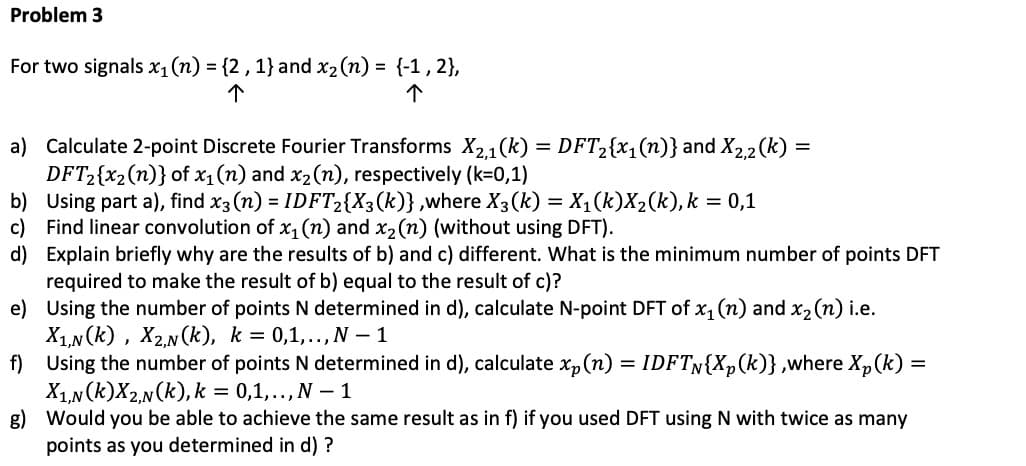Problem 3 For two signals x₁ (n) = {2, 1} and x₂ (n) = {-1, 2}, 个 个 a) Calculate 2-point Discrete Fourier Transforms X2,1(k) = DFT₂{x₁ (n)} and X2,2(k) = DFT₂{x₂ (n)} of x₁ (n) and x₂ (n), respectively (k=0,1) b) Using part a), find x3 (n) = IDFT2{X3(k)},where X3(k) = X₁(k)X₂(k), k = 0,1 c) Find linear convolution of x₁ (n) and x₂ (n) (without using DFT). d) Explain briefly why are the results of b) and c) different. What is the minimum number of points DFT required to make the result of b) equal to the result of c)? e) Using the number of points N determined in d), calculate N-point DFT of x₁ (n) and x₂ (n) i.e. X₁,N(K), X2,N(K), k = 0,1,.., N-1 f) Using the number of points N determined in d), calculate xp (n) = IDFTN{Xp (k)},where Xp (k) = X₁,N(K)X2,N(k), k = 0,1,.., N - 1 g) Would you be able to achieve the same result as in f) if you used DFT using N with twice as many points as you determined in d) ?
Problem 3 For two signals x₁ (n) = {2, 1} and x₂ (n) = {-1, 2}, 个 个 a) Calculate 2-point Discrete Fourier Transforms X2,1(k) = DFT₂{x₁ (n)} and X2,2(k) = DFT₂{x₂ (n)} of x₁ (n) and x₂ (n), respectively (k=0,1) b) Using part a), find x3 (n) = IDFT2{X3(k)},where X3(k) = X₁(k)X₂(k), k = 0,1 c) Find linear convolution of x₁ (n) and x₂ (n) (without using DFT). d) Explain briefly why are the results of b) and c) different. What is the minimum number of points DFT required to make the result of b) equal to the result of c)? e) Using the number of points N determined in d), calculate N-point DFT of x₁ (n) and x₂ (n) i.e. X₁,N(K), X2,N(K), k = 0,1,.., N-1 f) Using the number of points N determined in d), calculate xp (n) = IDFTN{Xp (k)},where Xp (k) = X₁,N(K)X2,N(k), k = 0,1,.., N - 1 g) Would you be able to achieve the same result as in f) if you used DFT using N with twice as many points as you determined in d) ?
Introductory Circuit Analysis (13th Edition)
13th Edition
ISBN:9780133923605
Author:Robert L. Boylestad
Publisher:Robert L. Boylestad
Chapter1: Introduction
Section: Chapter Questions
Problem 1P: Visit your local library (at school or home) and describe the extent to which it provides literature...
Related questions
Question
Only g please

Transcribed Image Text:Problem 3
For two signals x₁ (n) = {2, 1} and x₂ (n) = {-1, 2},
个
个
a) Calculate 2-point Discrete Fourier Transforms X2,1(k) = DFT₂{x₁(n)} and X2,2 (k) =
DFT₂{x₂ (n)} of x₁ (n) and x₂ (n), respectively (k=0,1)
b)
Using part a), find x3 (n) = IDFT2{X3(k)},where X3(k) = X₁(k)X₂(k), k = 0,1
c) Find linear convolution of x₁ (n) and x₂ (n) (without using DFT).
d)
Explain briefly why are the results of b) and c) different. What is the minimum number of points DFT
required to make the result of b) equal to the result of c)?
e)
Using the number of points N determined in d), calculate N-point DFT of x₁ (n) and x₂ (n) i.e.
X₁,N(K), X2,N(K), k = 0,1,.., N-1
f)
Using the number of points N determined in d), calculate xp (n) = IDFTN{Xp (k)},where Xp (k) =
X₁,N(K)X2,N(k), k = 0,1,.., N - 1
g) Would you be able to achieve the same result as in f) if you used DFT using N with twice as many
points as you determined in d) ?
Expert Solution
This question has been solved!
Explore an expertly crafted, step-by-step solution for a thorough understanding of key concepts.
Step by step
Solved in 7 steps with 7 images

Knowledge Booster
Learn more about
Need a deep-dive on the concept behind this application? Look no further. Learn more about this topic, electrical-engineering and related others by exploring similar questions and additional content below.Recommended textbooks for you

Introductory Circuit Analysis (13th Edition)
Electrical Engineering
ISBN:
9780133923605
Author:
Robert L. Boylestad
Publisher:
PEARSON

Delmar's Standard Textbook Of Electricity
Electrical Engineering
ISBN:
9781337900348
Author:
Stephen L. Herman
Publisher:
Cengage Learning

Programmable Logic Controllers
Electrical Engineering
ISBN:
9780073373843
Author:
Frank D. Petruzella
Publisher:
McGraw-Hill Education

Introductory Circuit Analysis (13th Edition)
Electrical Engineering
ISBN:
9780133923605
Author:
Robert L. Boylestad
Publisher:
PEARSON

Delmar's Standard Textbook Of Electricity
Electrical Engineering
ISBN:
9781337900348
Author:
Stephen L. Herman
Publisher:
Cengage Learning

Programmable Logic Controllers
Electrical Engineering
ISBN:
9780073373843
Author:
Frank D. Petruzella
Publisher:
McGraw-Hill Education

Fundamentals of Electric Circuits
Electrical Engineering
ISBN:
9780078028229
Author:
Charles K Alexander, Matthew Sadiku
Publisher:
McGraw-Hill Education

Electric Circuits. (11th Edition)
Electrical Engineering
ISBN:
9780134746968
Author:
James W. Nilsson, Susan Riedel
Publisher:
PEARSON

Engineering Electromagnetics
Electrical Engineering
ISBN:
9780078028151
Author:
Hayt, William H. (william Hart), Jr, BUCK, John A.
Publisher:
Mcgraw-hill Education,